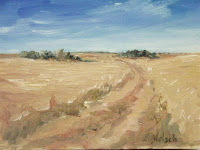
Lane to the old Betke place
The wheel tracks captured in Linda Welsch’s painting once led to a busy farmstead in Buffalo County, Nebraska. What Linda painted this fall looks a lot more like the land before farmers plowed the plains, maybe a little like the wagon wheel tracks of the Oregon trail near here. (Click to see larger.)
At the height of its farm history, the Betke place featured a sturdy two-story farm house, a big red barn, a fleet of machinery, a large garden, and a thriving generation of German-stock farmers. The Betkes grew corn, milo, wheat and alfalfa. They kept a cow herd, pigs, poultry, and a small beef feedlot. The farmstead had a chicken house, a wash house, a duck house, a feed bin, a granary, a machine shop, a windmill, cattle pens, and a cow shed—all those fixtures of the mixed grain and livestock farm in the twentieth century.
A tornado about twenty years ago took most of buildings. The grinding of time changed the farm’s future. At one time, an Extension agent advised me to drill a well in the middle of this quarter section and irrigate it with a pivot. Another adviser, from the soil conservation agency, told me I should install better terraces.
Those two clumps of trees you see in the painting are about all that remains of my grandparents’ farm. The one on the left flanked the farmstead, the other is a windbreak they planted after the Dust Bowl.
Today, much of the quarter is enrolled in CRP, the rest is native pasture and dryland corn and beans. A young farmer from up the road keeps an eye on the place, plants the crops, and tends the cows.
As I look at how Linda saw the farm in this painting, it settles my heart. I miss the old folks and that bustling farm. But I also see more clearly what underlies our daily lives in agriculture: the land, the sky, and the path home.
About Linda Hotovy Welsch: Linda has been a friend to Successful Farming for years. We have long admired her paintings portraying the people and landscapes of the rural Midwest. She lives on a farm in central Nebraska with Roger Welsch, the acclaimed writer, folklorist, tractor collector and Native American expert. Linda issues an occasional e-mail newsletter, “field notes” to a few friends. I’ve assembled a few of her most recent works, along with some of her informal comments on the paintings, in a Flickr photo gallery, Linda's paintings. You can view a wider selection of her paintings on a Successful Farming Web page, Linda's Art Page.
